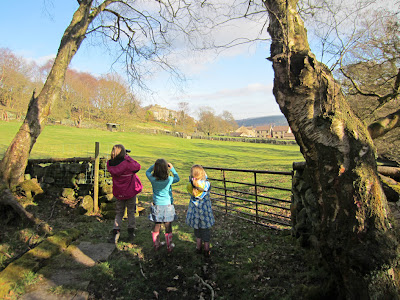Thank you to everyone who came to the Airedale Otters Christmas event at St Ives and made it such fun occasion.
The weather was great - it was a beautiful bright, sunny day, but quite chilly. We started with a walk around Coppice Pond and a visit to the bird feeders. It was a quiet morning for wildlife, so we soon headed back to the warmth of the St Ives visitor centre with its lovely roaring fire. The rooms were beautifully prepared for us by the Friends of St Ives - many thanks to them. So many Otters turned up it was a tight squeeze!
We had hot dogs cooked on the range, and mince pies, buns and juice. The mulled wine for the grown-ups went very quickly!
Everyone had the chance to make felt bird decorations of Robin, Blue Tit, Coal Tit, Chaffinch, Goldfinch, or House Sparrow – and to learn to identify these birds as we made them.
A Goldfinch and Blue Tit hanging from our Christmas tree!
This year’s bird
song quiz was about the more unusual, weird and funny noises some
British birds make. We heard the Booming Bittern, the yaffling Green Woodpecker, the screaming Swift, and the churring Nightjar – not to forget
the Corncrake, which rhymes with corn flake! We also learnt that some
birds say their name: Cuckoo, Chiffchaff, and Jackdaw.
Click on the name of a bird above to learn more about the bird and listen to its song again. The quiz prize was a bird feeder and bird ID book, which the winners donated to their local school. Well done!
Finally, Cam got his hands dirty and mushed up a big pile of lard, mealworms and seeds to make some bird feeders. Here are two we made, hanging in an Otter’s garden.
Click on the name of a bird above to learn more about the bird and listen to its song again. The quiz prize was a bird feeder and bird ID book, which the winners donated to their local school. Well done!
Finally, Cam got his hands dirty and mushed up a big pile of lard, mealworms and seeds to make some bird feeders. Here are two we made, hanging in an Otter’s garden.
By feeding the birds in your garden you’ll be helping them survive periods of severe winter weather. This will help them be in the best condition at the start of the breeding season in the spring. Let us know what birds you seen on your feeders this winter.
Thanks again to everyone who came and made it such fun event. We will soon be posting a full list of events for 2013 - along with details of our next event, which coincides with the RSPB Big Garden Birdwatch on the weekend of 26/27th January.
The leaders of the Airedale Otters would like to thank all our members and parents for their continued attendance this year. We hope to see you all again in January.
Have a fantastic Christmas and a Happy New Year!
































.jpg)
.jpg)


.jpg)












